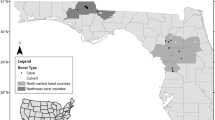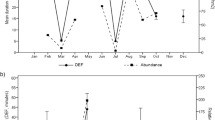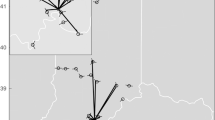Abstract
We comment on a recent study (Vasenkov et al. in Dokl Biol Sci 513:395–399, 2023, https://doi.org/10.1134/S0012496623700746) presenting the movement paths of three greater noctule bats (Nyctalus lasiopterus), two juveniles and an adult, tracked from Russia in September–October 2020 and 2021, with particular emphasis on the unprecedented straight-line migration of a juvenile male to Italy. Notably, the juvenile's extraordinary 2515 km migration marks the longest recorded (as the crow flies) movement in a bat species. We argue that the two juveniles may represent cases of dispersal. Despite the attention garnered by Vasenkov et al.’s findings, caution is warranted in interpreting the broader migration picture. The paper’s dissemination underscores a potential oversimplification, neglecting key insights from recent work conducted in Italy that documented the year-round presence, hibernation, and parturition of N. lasiopterus in an area of the Friuli Venezia-Giulia region where the juvenile male tracked from Russia stopped over. Besides, inferring the existence of migratory routes based on small numbers of tracked bats is insufficient. The oversight of these findings may imply a misleading narrative about the species' behaviour, likely representing a case of partial migration, a pattern widespread among migratory bat species.
Similar content being viewed by others
Avoid common mistakes on your manuscript.
A recent study (Vasenkov et al. 2023) presents information regarding the movement of three greater (or giant) noctule bats (Nyctalus lasiopterus). The individuals, two juveniles (one male and one female) and one adult female were monitored using GPS-GSM devices and the tracking period spanned mid-September and mid-October in both 2020 and 2021, totalling 22–28 days of data collection. The adult female exhibited a predominantly linear trajectory covering 1754 km southwestward to Bulgaria, where data collection was interrupted (Vasenkov et al. 2023). In contrast, the two juveniles displayed more erratic movements. The female juvenile's route extended to Poland, while the male juvenile was followed as far as northwest Italy, approximately 100 km from the French border, where data collection ceased (Vasenkov et al. 2023).
Despite its reliance on a sample size of only three individuals, this study is intriguing as it illuminates the spatial behaviour of a cryptic and relatively unknown European vespertilionid. Notably, the bats demonstrated a daily travel range of 359–445 km, with the juvenile male achieving an unprecedented straight-line distance of 2515 km, which is the longest straight-line movement known for a bat species to date.
Studies such as these show the practical application of GPS technology in investigating bat movement, particularly for species with sufficient body mass to apply a GPS unit. In comparison, conventional methods like bat ringing, despite appearing much more economical, prove less cost-effective. This is due to the substantial search effort required for recapturing ringed bats, coupled with concerns raised about the potential adverse effects of ringing on bat well-being (Lobato-Bailón et al. 2023). Furthermore, the recapture of ringed bats only yields data regarding two points, while GPS systems offer the capability to continuously track the bats’ actual movement en route.
Nyctalus lasiopterus is known for undertaking extensive migrations across central and Eastern Europe (Hutterer et al. 2005). Still, it may also establish year-round residency in particular areas of Western Europe or engage in altitudinal migration patterns, wherein males and females segregate based on altitude (Ibáñez and Juste 2022). The data provided by Vasenkov et al. (2023) not only reaffirm the bats' inclination for extensive travel but also highlight a lack of a cohesive pattern. While not explicitly addressed in that study, the observed discrepancy may arise from the fact that the two juveniles, displaying a more erratic flight pattern than the only adult bat tracked, might have undertaken a dispersal flight instead of following the typical seasonal migration observed in the adult bat. Dispersal is widespread in bats and may involve either one or both sexes (Moussy et al. 2013). In common noctules (Nyctalus noctula), range expansion is accomplished through this mechanism (Kravchenko et al. 2020). Overall, labelling the movement recorded for the two juveniles as ‘migration,’ as done by Vasenkov et al. (2023), may be misleading.
The trajectory followed by the juvenile male is particularly interesting. One of the day roosts used by this bat in the Italian territory is situated in an area of the Friuli-Venezia Giulia region (northeast Italy) where Russo et al. (2023) documented the year-round presence of both common (Nyctalus noctula) and greater noctules roosting in a forest fragment amid an intensive agricultural landscape. In addition to revealing roost-tree selection patterns, Russo et al. (2023) provided unequivocal photographic evidence demonstrating that N. lasiopterus not only hibernates at the site but also gives birth (see also Fig. 1), and possibly mates. However, Vasenkov et al. (2023) did not consider Russo et al. (2023)'s findings, since they were not aware of the latter study when their work was already in press (D. Vasenkov, pers. comm.), and concluded that the juvenile male moved southwards in search of suitable climatic conditions for hibernation without mentioning the presence of a greater noctule population in that area. While this hypothesis is plausible, we contend that it should not be interpreted as indicative of a population-wide migration pattern, as we are confident that many greater noctules complete their entire life cycle in the region where the juvenile male from Russia made a stopover (Russo et al. 2023). Previous acoustic surveys conducted by Paniccia et al. (2023) further substantiate the summer presence of greater noctules in South Tyrol, situated on the southern side of the Eastern Alps. Overall, the tracking of the juvenile male bat from Russia to Italy does not conclusively demonstrate migration between these regions, which we nonetheless consider a plausible scenario.
Photographs of Nyctalus lasiopterus taken in the study area of Russo et al. (2023), depicting individuals recorded during winter (a) and newborns observed following parturition in summer (b). Photos by Anne Mäenurm
Consistent with the observed yearly fluctuations in the greater noctule population in the area (pers. obs.), a partial migration pattern may occur. In this pattern, only a segment of the bat population engages in long-distance migration, while another segment remains sedentary. Partial migration is a common phenomenon among vertebrates and is extensively documented in migratory bats (Rogers et al. 2022). However, a complete understanding of its genetic, physiological, and environmental determinants remains elusive (Chapman et al. 2011; Hegemann et al. 2019). In Europe, partial migration is common in long-distance migratory bat genera, including Nyctalus, Pipistrellus, and Vespertilio. In certain instances, such as with Nathusius' pipistrelles, hibernacula are shared by both migratory and sedentary conspecifics (Roer 1995; Rydell et al. 2014; O’Mara et al. 2016; Fleming 2019).
The fact that one tracked juvenile stopped over in an area that is home to significant colonies of greater noctules is intriguing. It suggests that the bat may have detected cues signalling the presence of conspecifics in the area, raising new questions about navigational skills in migratory bats.
The presentation of the findings, particularly the notion that greater noctules migrate to Italy and potentially winter there, has gained significant attention among bat specialists and enthusiasts and has been taken up on social media. However, it is crucial to exercise caution in interpreting this information. The suggestion of a fully migratory nature for the entire population is misleading for two reasons. Firstly, as already mentioned, the juvenile movement provided no conclusive evidence of migration. Secondly, even if it were a genuine migrating subject, it would still represent a single individual, insufficient to infer the migratory behaviour of the entire population. This interpretation overlooks Russo et al. (2023)’s findings (see also Paniccia et al. 2023) and implies a simplified narrative that may not fully capture the subtle and complex scientific reality of the situation. The oversimplification of the message could pose potential dangers as it may contribute to misconceptions about the species' behaviour. Emphasising the need for a more comprehensive understanding of the ecological dynamics and migration patterns of N. lasiopterus is paramount to avoid oversimplification and foster a more accurate scientific analysis.
In conclusion, we highlight that the management of migratory species presents a formidable challenge for conservation efforts. It is crucial to understand the migratory patterns of N. lasiopterus, which involves accurately interpreting the recorded movements, to effectively plan transnational conservation initiatives. This necessitates the integration of modern tracking technologies, such as GPS devices, alongside complementary methods such as stable isotope analysis and direct observations in roosting areas. By employing a multifaceted approach, encompassing both advanced technologies and traditional observational methods, we can glean comprehensive insights into the population ecology of greater noctules and develop conservation strategies that transcend national borders, ensuring the preservation of this species and its key habitats. We also strongly encourage the scientific community to adopt a more neutral terminology when discussing bat long-range movement and refrain from labelling any such movement as “migration” when its precise nature remains ambiguous or indeterminate due to limited or fragmented information.
References
Chapman BB, Brönmark C, Nilsson JÅ, Hansson LA (2011) The ecology and evolution of partial migration. Oikos 120:1764–1775. https://doi.org/10.1111/j.1600-0706.2011.20131.x
Fleming TH (2019) Bat migration. In: Breed MD, Moore J (eds) Encyclopedia of animal behavior, 2nd edn. Elsevier, Amsterdam, pp 605–610. https://doi.org/10.1016/B978-0-12-809633-8.20764-4
Hegemann A, Fudickar AM, Nilsson JÅ (2019) A physiological perspective on the ecology and evolution of partial migration. J Ornithol 160:893–905. https://doi.org/10.1007/s10336-019-01648-9
Hutterer R, Ivanova T, Meyer-Cords C, Rodrigues L (2005) Bat migrations in Europe: a review of banding data and literature. BfN-Schriftenvertrieb im Landwirtschaftsverlag. ISBN 3-7843-3928-X
Ibáñez C, Juste J (2022) Greater noctule bat Nyctalus lasiopterus (Schreber, 1780). In: Hackländer K, Zachos FE (eds) Handbook of the mammals of Europe. Springer, Cham. https://doi.org/10.1007/978-3-319-65038-8_65-1
Kravchenko KA, Vlaschenko AS, Lehnert LS, Courtiol A, Voigt CC (2020) Generational shift in the migratory common noctule bat: first-year males lead the way to hibernacula at higher latitudes. Biol Lett 16:20200351
Lobato-Bailón L, López-Baucells A, Guixé D et al (2023) Reappraising the use of forearm rings for bat species. Biol Conserv 286:110268. https://doi.org/10.1016/j.biocon.2023.110268
Moussy C, Hosken DJ, Mathews F et al (2013) Migration and dispersal patterns of bats and their influence on genetic structure. Mammal Rev 43:183–195. https://doi.org/10.1111/j.1365-2907.2012.00218.x
O’Mara MT, Bauer K, Blank D et al (2016) Common noctule bats are sexually dimorphic in migratory behaviour and body size but not wing shape. PLoS One 11:e0167027. https://doi.org/10.1371/journal.pone.0167027
Paniccia C, Zingg PE, Bellè A, Hilpold A, Reichegger F, Tappeiner U, Ladurner E (2023) Bioacoustic evidence for a continuous summer presence of the greater noctule bat, Nyctalus lasiopterus, in the Italian Alps. Mamm Res 68:411–416
Roer H (1995) 60 years of bat banding in Europe—results and tasks for future research. Myotis 32–33:251–261
Rogers EJ, McGuire L, Longstaffe FJ et al (2022) Relating wing morphology and immune function to patterns of partial and differential bat migration using stable isotopes. J Anim Ecol 91:858–869. https://doi.org/10.1111/1365-2656.13681
Russo D, Mäenurm A, Martinoli A et al (2023) Forest islands in farmland provide vital roost trees year-round for giant and common noctule bats: management implications. For Ecol Manag 540:121053. https://doi.org/10.1016/j.foreco.2023.121053
Rydell J, Bach L, Bach P et al (2014) Phenology of migratory bat activity across the Baltic Sea and the south-eastern North Sea. Acta Chiropt 16:139–147. https://doi.org/10.3161/150811014X683354
Vasenkov DA, Vasiliev NS, Sidorchuk NV, Rozhnov VV (2023) Autumn migration of greater noctule bat (Nyctalus lasiopterus): through countries and over mountains to a new migration flight record in bats. Dokl Biol Sci 513:395–399. https://doi.org/10.1134/S0012496623700746
Acknowledgements
We are thankful to three anonymous reviewers and D. Vasenkov for providing useful feedback on an earlier version of this article.
Funding
Open access funding provided by Università degli Studi di Napoli Federico II within the CRUI-CARE Agreement.
Author information
Authors and Affiliations
Contributions
All authors contributed to the study's conception. The first draft of the manuscript was written by Danilo Russo and all authors commented on previous versions of the manuscript. All authors read and approved the final manuscript.
Corresponding author
Ethics declarations
Conflict of interest
On behalf of all authors, the corresponding author states that there is no conflict of interest.
Additional information
Handling editor: Heiko Georg Rödel.
Publisher's Note
Springer Nature remains neutral with regard to jurisdictional claims in published maps and institutional affiliations.
Rights and permissions
Open Access This article is licensed under a Creative Commons Attribution 4.0 International License, which permits use, sharing, adaptation, distribution and reproduction in any medium or format, as long as you give appropriate credit to the original author(s) and the source, provide a link to the Creative Commons licence, and indicate if changes were made. The images or other third party material in this article are included in the article's Creative Commons licence, unless indicated otherwise in a credit line to the material. If material is not included in the article's Creative Commons licence and your intended use is not permitted by statutory regulation or exceeds the permitted use, you will need to obtain permission directly from the copyright holder. To view a copy of this licence, visit http://creativecommons.org/licenses/by/4.0/.
About this article
Cite this article
Russo, D., Mäenurm, A., Martinoli, A. et al. Of greater noctule “migration” from Russia to Italy: a comment on Vasenkov et al. (2023). Mamm Biol (2024). https://doi.org/10.1007/s42991-024-00421-7
Received:
Accepted:
Published:
DOI: https://doi.org/10.1007/s42991-024-00421-7





